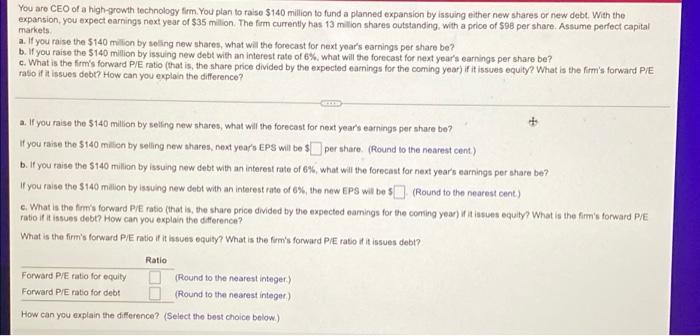You are CEO of a high-growth technology firm. You plan to raise $140 million to fund a planned expansion by issuing either new shares or new debt. With the expansion, you expect earnings next year of $35 million. The firm currently has 13 milion shares outstanding, with a price of $98 per share. Assume perfect capital markets a. If you raise the 5140 million by soling new shares, what will the forecast for next year's earnings per share be? b. If you raise the $140 million by issuing new debt with an interest rate of 6%, what will the forecast for next year's earnings per share be? c. What is the firm's forward P/E ratio (that is, the share price divided by the expected earnings for the coming year) if it issues equity? What is the firm's forward PE ratio if it issues debt? How can you explain the difference? a. If you raise the 5140 million by selling now shares, what will the forecast for next year's earnings per share be? If you raise the $140 million by selling new shares, next year's EPs will be $ per share. (Round to the nearest cent) b. If you raise the $140 million by issuing new debt with an interest rate of 6% what will the forecast for next year's earnings per share be? If you raise the $140 million by issuing new dubt with an interest rate of 8%, the new EPS will be $ (Round to the nee ho nearest cent) c. What is the form forward Ple ratio (that is, the share price divided by the expected oamings for the coming years inte equity? What is the firm's forward PIE ratio if it issues debt? How can you explain the difference? What is the firm's forward P/E ratio if it huts equity? What is the firm's forward Ple ratio if it issues debt? Ratio Forward P/E ratio for equity Forward P/E ratio for debt (Round to the nearest integer) (Round to the nearest integer) How can you explain the difference? (Select the best choice below) You are CEO of a high-growth technology firm. You plan to raise $140 million to fund a planned expansion by issuing other new shares or new debt. With the expansion, you expect earnings next year of $35 million. The firm currently has 13 milion shares outstanding, with a price of $98 per share. Assume perfect capital markets a. If you raise the $140 million by seling new shares what will the forecast for next year's earnings per share be? b. If you raise the $140 milion by issuing new debt with an interest rate of 6%, what will the forecast for next year's earnings per share be? c. What is the firm's forward Pre ratio (that is, the share price divided by the expected earnings for the coming your) it issues equity? What is the firm's forward PE ratio if it issues debt? How can you explain the difference? GHID c. What is the firm's forward PlE ratlo (hat is, the share price divided by the expected earnings for the coming year) in issues equity? What is the firm's forward Pre ratio issues debt? How can you explain the difference? What is the firm's forward PE ratio i uns equity? What is the fem's forward PE tatio issues debt? Ratio Forward PE ratio for equity (Round to the nearest Integer) Forward Pre ratio for det D_(Round to the nearest Integer) How can you explain the difference? (Select the best choice below) A The higher PE ratio is justified because with leverage the EPS will decrease at a faster rate OB. The lower P/E ratio is justified because with leverage, the EPS wil decrease at a faster rate. OC The lower PE ratio is justified because with leverage, EPS will grow at a faster rate OD The higher PlE ratio is justified because with leverage, EPS will grow at a faster rate








